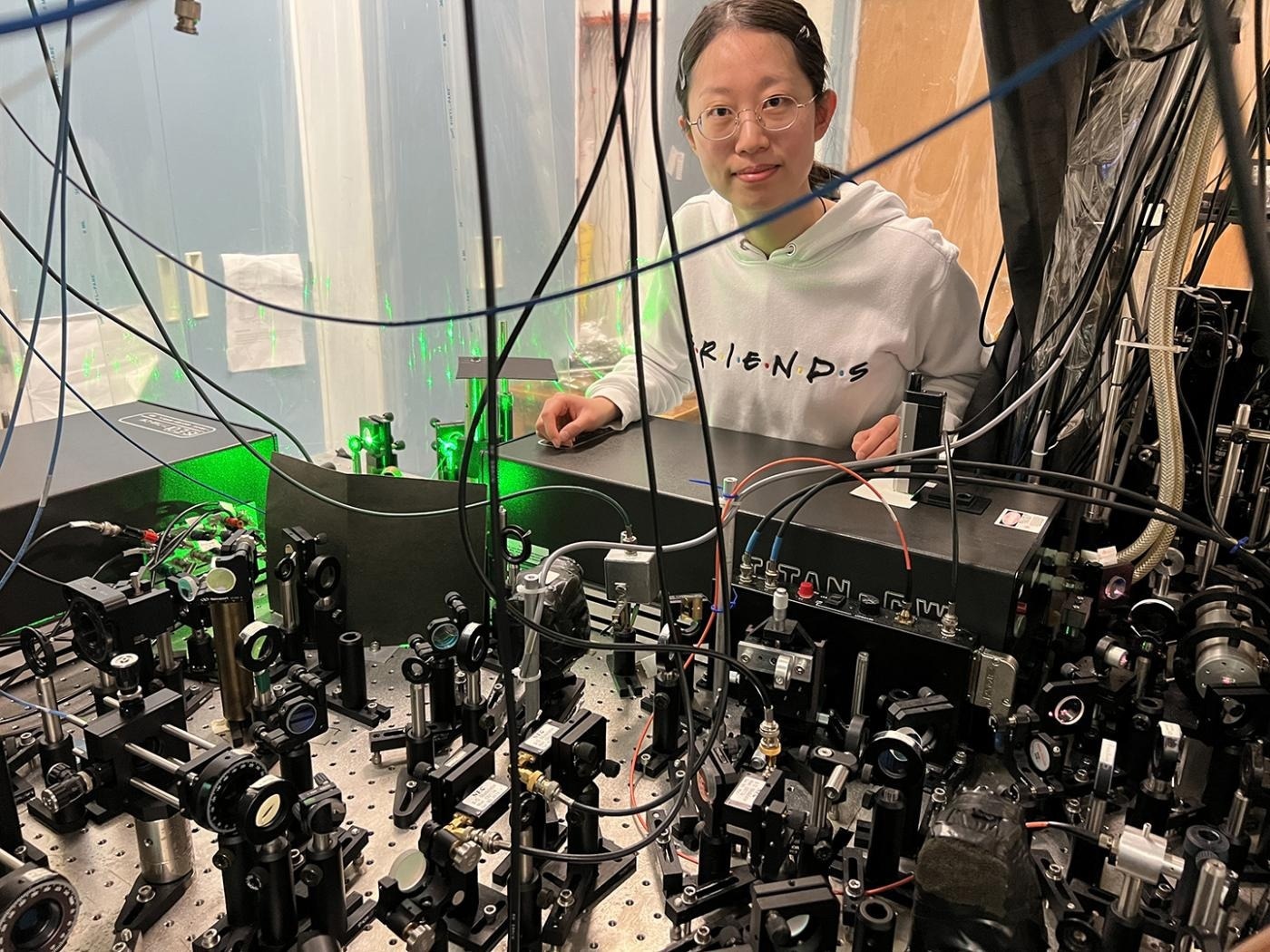Conducting new experiments by making use of one-dimensional gases of ultra-cold atoms shows a generality in how quantum systems made of several particles are altered over time after a huge influx of energy that flings the system out of equilibrium.

New experiments with ultra-cold atomic gases uncover universal physics in the dynamics of quantum systems. Penn State graduate student Yuan Le, the first author of the paper describing the experiments, stands near the apparatus she used to create and study one-dimensional gases near absolute zero. Image Credit: David Weiss, Penn State
At Penn State, a physics group showed that these gases respond instantly, “evolving” with features that are usual to all “many-body” quantum systems discarded of equilibrium in this way.
A study explaining the experiments appeared in Nature on May 17th, 2023.
Many major advances in physics over the last century have concerned the behavior of quantum systems with many particles.
David Weiss, Research Team Leader and Distinguished Professor, Physics, The Pennsylvania State University
Weiss added, “Despite the staggering array of diverse ‘many-body’ phenomena, like superconductivity, superfluidity, and magnetism, it was found that their behavior near equilibrium is often similar enough that they can be sorted into a small set of universal classes. In contrast, the behavior of systems that are far from equilibrium has yielded to few such unifying descriptions.”
Such quantum many-body systems are ensembles of particles, such as atoms, which are free to move around relative to each other. When they are a few combinations of thick and cold enough, which could vary based on the context, quantum mechanics—the basic theory explaining the properties of nature at the atomic or subatomic scale—is needed to explain their dynamics.
Dramatically out-of-equilibrium systems are regularly made in particle accelerators when pairs of heavy ions have collided at speeds next to the speed of light.
The collisions generate a plasma—made of the subatomic particles named “quarks” and “gluons”—that arises very early in the collision and could be explained by a hydrodynamic theory.
This is similar to the classical theory utilized to explain air flow or other moving fluids—well before the plasma extends to the local thermal equilibrium. However, what happens in the astonishingly short time before hydrodynamic theory could be utilized?
The physical process that occurs before hydrodynamics can be used has been called ‘hydrodynamization’.
Marcos Rigol, Research Team Leader and Professor of Physics, The Pennsylvania State University
Rigol added, “Many theories have been developed to try to understand hydrodynamization in these collisions, but the situation is quite complicated and it is not possible to actually observe it as it happens in the particle accelerator experiments. Using cold atoms, we can observe what is happening during hydrodynamization.”
The scientists of Penn State took benefit of two unique features of one-dimensional gases, which have been trapped and made to be cooled to near absolute zero by lasers, to comprehend the progress of the system after it is thrown out of equilibrium, but before hydrodynamics could be applied.
The first feature is known to be experimental. Interactions happening in the experiment could be turned off abruptly at any point after the influx of energy, so the progress of the system could be observed directly and quantified. Particularly, they noted the time evolution of one-dimensional momentum distributions following the sudden quench in energy.
Ultra-cold atoms in traps made from lasers allow for such exquisite control and measurement that they can really shed light on many-body physics. It is amazing that the same basic physics that characterize relativistic heavy ion collisions, some of the most energetic collisions ever made in a lab, also show up in the much less energetic collisions we make in our lab.
David Weiss, Research Team Leader and Distinguished Professor, Physics, The Pennsylvania State University
The second one is a theoretical feature. A collection of particles that communicate with each other in a complex method could be explained as a collection of “quasiparticles” whose mutual interactions are way easier.
Unlike in the majority of the systems, the quasiparticle description of one-dimensional gases is mathematically precise. It enables a highly clear description of why energy has been quickly redistributed throughout the system once it is thrown out of equilibrium.
“Known laws of physics, including conservation laws, in these one-dimensional gases imply that a hydrodynamic description will be accurate once this initial evolution plays out,” stated Rigol.
Rigol added, “The experiment shows that this occurs before local equilibrium is reached. The experiment and theory together therefore provide a model example of hydro-dynamization. Since hydro-dynamization happens so fast, the underlying understanding in terms of quasi-particles can be applied to any many-body quantum system to which a very large amount of energy is added.”
Besides Weiss and Rigol, the research group at Penn State also includes authors like Yuan Le, Yicheng Zhang, and Sarang Gopalakrishnan. The study was financially supported by the U.S. National Science Foundation. Computations were performed at the Penn State Institute for Computational and Data Sciences.
Journal Reference:
Le, Y., et al. (2023) Observation of hydrodynamization and local prethermalization in 1D Bose gases. Nature. https://doi.org/10.1038/s41586-023-05979-9.